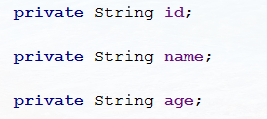数据库的字段:

对应的实体类:

方案一:
在XML映射文件中使用的resultMap,优点:可以被重复使用。
<resultMap id="BaseResultMap" type="com.dao.entity.UserInfoEntity"> <!-- 用id属性来映射主键字段 --> <id column="_id" jdbcType="VARCHAR" property="id" /> <!-- 用result属性来映射非主键字段 --> <result column="name" jdbcType="VARCHAR" property="name" /> </resultMap>
通过里面的id标签和result标签来建立映射关系,由property和column分别指定实体类属性和数据表的列名。
方案二:
让字段的别名与实体类的属性名相同,优点:操作简单,容易理解。缺点:当这样的语句出现的次数过多的时候,到时冗余代码增多,这些别名不能重用。
<select id="selectAll" resultType="com.dao.entity.UserInfoEntity"> select _id id, name, age from user </select>
@Select("select _id id, name, age from user") List<UserInfoEntity> selectAll();
方案三:
使用Map集合封装结果集,在MyBatis中字段名作为key,字段所对应的数据作为value。优点:可以在多表操作时使用。
<select id="selectUserAll" resultType="java.util.Map"> select * from user </select>
方案四:
使用注解@Results和@Result
这两个注解与XML文件中的标签相对应: @Results对应resultMap @Result对应result
@Select("select * from user where name = #{name}") @Results({ @Result(property = "id", column = "_id"), @Result(property = "name", column = "name") }) UserInfoEntity getUserByName(@Param("name") String name);
@Select("select * from user where name = #{name}") @Results(id = "userMap", value = { @Result(property = "id", column = "_id"), @Result(property = "name", column = "name") }) UserInfoEntity getUserByName(@Param("name") String name); @Select("SELECT * FROM user") @ResultMap("userMap") //公用@Results List<UserInfoEntity> findUserAll();
方案五:
通过配置属性来完成映射,Mybatis给我们提供了一种映射方式,如果属性的命名是遵从驼峰命名法的,数据列名遵从下划线命名, 那么可以使用这种方式,类似如下:
userName对应user_name;
userId对应user_id;
SqlSessionFactoryBean sqlSessionFactoryBean = new SqlSessionFactoryBean(); Configuration configuration = new Configuration(); configuration.setMapUnderscoreToCamelCase(true); sqlSessionFactoryBean.setConfiguration(configuration);